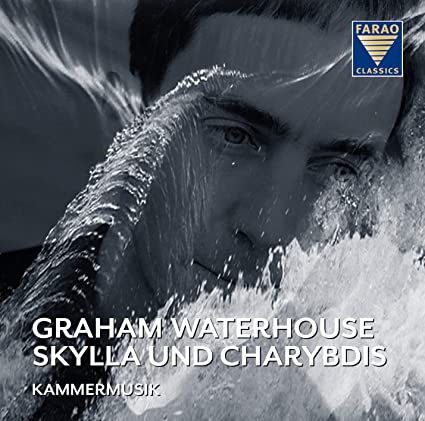

Rhapsodie Macabre (Piano & String Quartet) Bei Nacht (Piano Trio) Trilogy (Piano Quintet) Bells of Beyond (Piano Trio) Kolomyjka (Piano Quartet) Skylla und Charybdis (Piano Quartet)
Let me start this review by pointing out that British composer and cellist Graham Waterhouse (b. 1962) must have a predilection for subject matters that deal with the darker side of the spirit world and/or abstract fears inherent to the human condition. At least that's the impression I get from the generally dark and evanescent sound and textures of the music, and the fact that the booklet notes explain how the pieces broach subjects like the Dies irae, a darkly morbid moon, otherworldly and transcendent sounds, spectral dancers and sea monsters, which is what Skylla und Charybdis refers to. These are the two sea monsters from Greek mythology guarding each side of the Strait of Messina. Graham Waterhouse explains: "Choosing between Scylla and Charybdis is a metaphor which means »opting for the lesser of two evils«. The composer of today steers a similarly precarious path, facing questions such as: embracing or renouncing tradition; use of tonal centres or atonality; adhering to pre-conceived musical forms or use of narrative forms; allowing one instrument to dominate, or integrating them. In my mind the vision of the perilous and deadly Scylla and Charybdis mirrors these and other dilemmas facing composers, where possible danger may lie in store for those siding too closely with one extreme or the other."
One of Graham Waterhouse's composition teachers was Robin Holloway, and what I had mentioned about the teacher applies to the student as well: "the music constantly ebbs and flows from tonal to atonal, basic to complex rhythms, old logic to new logic. But despite these contradictory elements, it's Waterhouse's fine weaving of the various motivic aspects of the work that forms a binding, if at times perplexing thread. This is music that requires attentive participation from the listener. Like a detailed story, if you skip a chapter or even a single page, the plot easily deteriorates." This composer has a flair for bringing together disparate elements that as a whole create a unified sense of cohesive development and direction. A perfect example of this occurs in the final segment of the Rhapsodie Macabre in which he combines the 'Dies irae' motif with Lisztian elements and (intentional or not) a snippet from Tuileries from Mussorgsky's Pictures at an Exibition to great effect.
In this recording Graham Waterhouse himself plays the cello and is joined by Katharina Sellheim (piano), David Frühwirth (violin), Namiko Fuse (violin), and Konstantin Sellheim (viola). If you enjoy chamber music and are looking to hear something compelling, innovative and yet well blueprinted, this is something I highly endorse.
Jean-Yves Duperron - February 2021